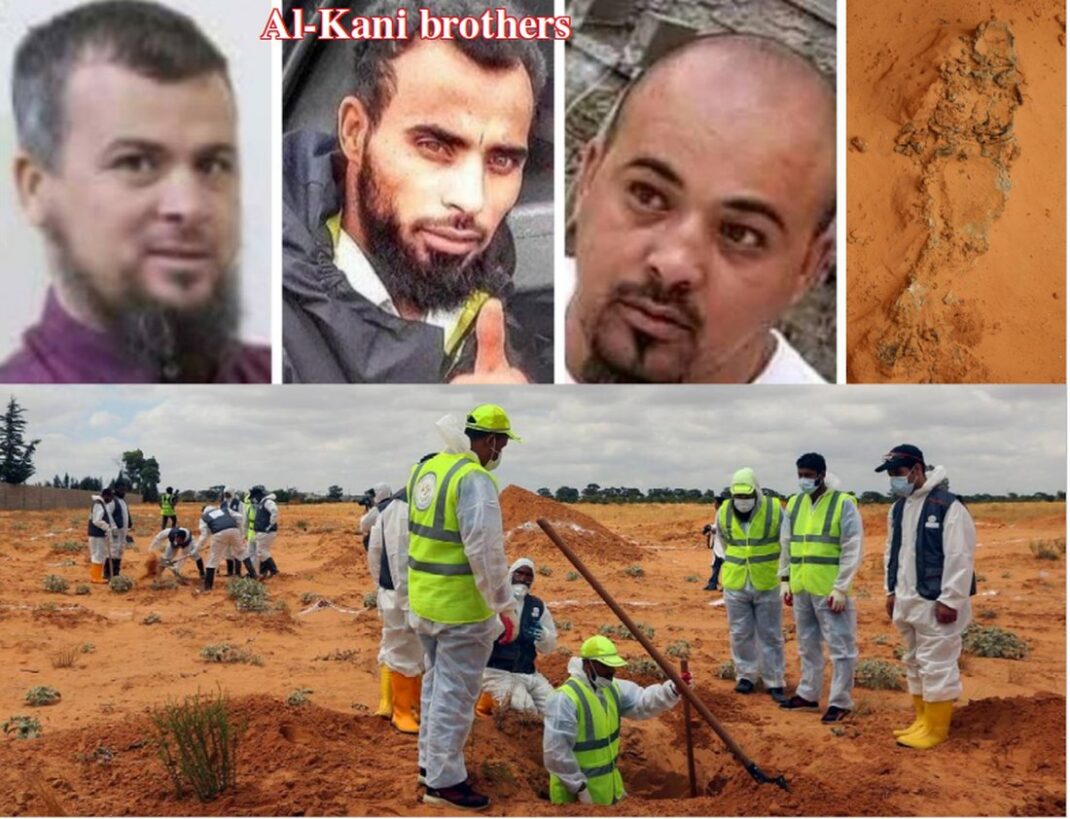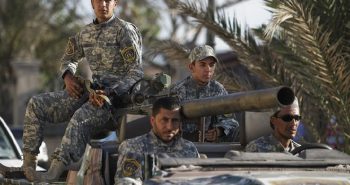By Daniel Hilton
 Khalifa Haftar’s LNA used this western Libyan town to launch his assault on Tripoli. In its wake, MEE finds a traumatised place littered with mass graves.
Khalifa Haftar’s LNA used this western Libyan town to launch his assault on Tripoli. In its wake, MEE finds a traumatised place littered with mass graves.
.PART (II)
Tarhuna’s torture prisons
Rumours of the torture prison the Kaniyat had created in a local agricultural testing centre had spread for weeks before they left Tarhuna, and the Kanis knew it.
In December, they had erected earth berm fortifications on two sides, fearing reprisal attacks from the families of those detained there.
When GNA forces eventually took the complex, they found seven, square-metre compartments, each of which was just large enough to accommodate a crouched man. On the counter above them lay mounds of ash from fires the Kaniyat used to turn the tiny cells into ovens.
“When we discovered this place we found one man still crouched inside an oven – he was alive but in a terrible state. He wouldn’t come out, he thought we were the Kaniyat playing a trick on him,” says Kosher.
Much of the facility is now blackened and charred, following fires Tarhunis lit in anguish when they realised their relatives couldn’t be found. But cardboard mattresses and fingerprints smeared down cell walls hint at its former use.
Ali Asaid Abu Zweid was held in one of these cells for 45 days, during which he barely spoke a word to the detainees to his left and right.
“We remained almost completely silent while held there, because no one thought it would be safe to talk to each other,” he says.
It’s unclear exactly why he was seized and held here, though Abu Zweid suspects it’s because he’d fought alongside pro-GNA Misratans against the Islamic State group in Sirte in 2015, but refused to take up arms against them in Tripoli.
He lost 30kg over a month and a half. “When they took someone off to be interrogated you’d hear gunshots,” he recalls, standing outside his former cell. “Sometimes the prisoners would come back, sometimes they had been killed.
“Occasionally they’d light fires over the ovens – it depended on our guards’ mood.”
Further into town, the Kaniyat used a former interior ministry security branch as a detention facility, where they held the majority of prisoners. Scores were confined here at once, crammed into half-a-dozen rooms strewn with plastic bottles used as toilets.
In one cell, brightly coloured children’s shoes are scattered over the floor.
Like the agricultural centre, the majority of people held here are still missing. Left behind by the Kaniyat instead are a falanga instrument to beat detainees’ feet and a mural of Mohsen al-Kani, staring out into the courtyard and giving the thumbs up.
A few names of people and places have been etched into the heavy metal doors that locked people in, along with dates. Officials investigating the disappearances believe these signify days when events happened, including purges. Some dates have several marks scored beside them, possibly marking the number of people killed at that time.
The cost of the Kanis
Tarhunis are still counting the cost to their town’s social fabric. The Kanis turned cousin against cousin. Those who managed to flee the town say they have been subject to vicious rumours.
But for women like Gazalla Ali Awness, who watched the Kani snatch seven of her sons, just providing for the dependents they left behind is a struggle. She now has around 40 grandchildren to support.
“The oldest man we have left is this one, he is 13,” she says, running her fingers through a boy’s thick black hair.
Surrounded by children, Awness looks up at the sky and flings out her arms, desperation and loss cracking her voice. “I don’t want money or food, I just want my sons, give me just one.”
Without a body, moving on mentally and emotionally can be near impossible. But economically, too. Under conservative Islamic tradition, a woman can’t remarry until her husband is confirmed dead.
With so many missing, and so many bodies yet to be identified, several of Tarhuna’s women are unable to turn a page or secure support from a new breadwinner.
“Now I have to do everything myself, and provide everything for my grandchildren and their mothers,” Awness says.
Though it has been weeks since the Kaniyat last stalked these streets, nerves are frayed.
Residents told MEE they avoid reporting relatives and friends who are missing because people they saw as complicit with the Kanis’ rule can still be seen around the municipal office.
Just the sight of men carrying weapons is too much for children of the Jaballah family, who burst into tears and hide every time the security services roll past their home.
Tarek Ali al-Jaballah was shot on the street in front of his young son in December. The next day, the Kaniyat rounded up 10 more members of the family. “Leave no men,” Sabri al-Gharb, a former Gaddafi loyalist leading the raid, is reported to have said.
“I have lost my husband, four brothers, one uncle and four cousins,” Rabia al-Jaballah says, fighting back tears. “I’m still frightened.”
“My brother was shot,” a teenage girl sitting behind her says.
“My father is missing,” another adds. “I miss him. I have dreams, I wanted to become a doctor, but I can’t do this without him.”
Reprisals in Tarhuna
The days that followed the GNA forces taking Tarhuna were pandemonium, with looting, arson and arrests recorded in several victorious fighters’ social media posts.
Lions kept by Mohsen and suspected to be fed with his victims were shot dead at his abandoned home.
Sources in the town told MEE at the time that extrajudicial killings were carried out. Kosher insists just a couple of people were killed in an inter-family dispute, although sources in western Libya have quietly acknowledged that reprisal killings could have reached the dozens.
Pro-Haftar media has seized on this narrative, ignoring the mass graves or blaming them on Syrian mercenaries while disassociating the LNA from the Kaniyat.
Yet the Kanis, the Kaniyat fighters and their families – totalling around 15,000 people overall – are still hosted by Haftar in east Libya.
Abdul-Rahim al-Kani has married into a prominent tribal family in the eastern city of Ajdabiya, whose fighters fought alongside the Kaniyat in Tripoli, and has even reportedly travelled to Germany for medical treatment.
The Kaniyat presence in the east is not particularly welcome, however. Mahmoud al-Werfalli, an LNA commander wanted by the International Criminal Court for war crimes, reportedly refused to allow the Kanis to settle in Haftar’s capital Benghazi.
“They’re not accepted there, they’re considered radioactive,” Harchaoui, the analyst, says. “If you go to war together, and then the war turns out to be a catastrophe on every level, then you’re going to hate each other.”
That said, during the Tripoli offensive, Haftar and his backers, including the UAE media, talked up the Kaniyat and stressed its legitimacy as part of the LNA. At one stage, the Kanis’ militia was combined with veteran LNA unit the 22nd Brigade to create the 9th Brigade, consolidating its place in Haftar’s ranks cosmetically and practically.
“I’m sure that Haftar was not receiving a text message every time a kid was killed, of course not, but that doesn’t take away from the sense of responsibility and complicity,” Harchaoui says.
“You can call it indirect, if you want. You can call it opaque, if you want. But it’s still complicity with an actor that everybody knew committed these atrocities.”
Fatou Bensouda, the ICC’s prosecutor, has said the discovery of men, women and children buried in Tarhuna’s mass graves “may constitute evidence of war crimes or crimes against humanity”.
The ICC prosecutor’s office told MEE it is “following up on this matter in particular with the competent Libyan authorities, in accordance with the principle of complementarity, to ensure that these mass graves are investigated”.
The LNA, meanwhile, described the mass graves as “crimes against humanity”.
“They were committed before the army went to Tripoli when the Kaniyat militia was affiliated with the forces of the Government of National Accord,” LNA spokesman Major General Ahmed al-Mismari told MEE.
Mismari would not commit to sending any wanted people in LNA territory to The Hague if requested by the ICC, and did not respond to questions about whether Haftar’s forces took responsibility for crimes committed by militias fighting under their banner.
In Tarhuna, there’s a growing realisation that the remains of all the town’s missing can only be recovered if the Kaniyat reveal their whereabouts. “Those in the east know where the bodies are buried,” says Kosher.
And for Tarhuni survivors like Rabia al-Jallabah, the onus is on Haftar to recognise the murders committed under his watch and stop giving shelter to those responsible.
“We want the UN to put pressure on Haftar. All we want is for the criminals who escaped to the east to be brought to justice,” she says. “They will do in the east what they did here.”
***
Tarhuna timeline: 2011 – 2020
How a town of 40,000 people became pivotal in the Libyan conflict:
2011: A Nato-backed uprising against Muammar Gaddafi topples the longtime autocrat, who is killed in October.
2012: Ali al-Kani, the only Kani brother to rebel against Gaddafi, is murdered on the road to Tajoura by a group of men, including some from the rival Naaja family. Mohammed al-Kani, who is in Saudi Arabia for Hajj, orders no action to be taken until he is back.
Mohammed’s return to Tarhuna is followed by a string of murders and lynchings. One man suspected of killing his brother is paraded in a central square. The reprisals are the start of the Kanis’ ascent.
2014: Libya is divided by a new civil war. The Kani clan back the Tripoli-based Libya Dawn administration and reject Haftar’s offensive against Islamists and militants in Benghazi.
2015: The Kanis have full control over Tarhuna. They now control a force of 4,000 men known as the Kaniyat, or 7th Brigade, absorbing local security services.
2017: Millions of migrants and refugees passing through Libya en route to Europe prompt the Kani to set up an anti-smuggling operation.
2018: The Kanis agree deals with rivals in Misrata and Zintan, before launching an assault on Tripoli. The Kaniyat attacks the Libyan capital, claiming it is doing so to stop corruption and embezzlement, although in reality it wants funds and influence. To the Kanis’ chagrin, the Mistrans largely stay out of the conflict: the assault ultimately backfires and costs more than 100 deaths.
2019: Haftar allies with the Kanis: the Kaniyat become the 9th Brigade of his Libyan National Army (LNA). In April, the LNA assault Tripoli from Tarhuna and Gharyan. Despite believing the conflict would last weeks, the offensive drags on.
In September Mohsen al-Kani is killed alongside younger brother Abdul Azim. The Government of National Accord (GNA) counterattacks Tarhuna in October and December, exposing LNA weaknesses. In retaliation the Kaniyat take out reprisals on the Tarhuna’s residents.
2020: In late May the LNA is struggling to hold its positions around Tripoli, and pro-Haftar Wagner Group Russian mercenaries retreat from the frontline. As LNA fighters begin to retreat, the Kaniyat fire on them in an attempt to stop the collapse.
GNA forces capture Tarhuna in early June. The Kanis and Kaniyat flee east.
***
Daniel Hilton is Middle East Eye’s senior news editor. Previously he was based in Beirut, where he was region editor of Lebanon’s The Daily Star newspaper.
___________





